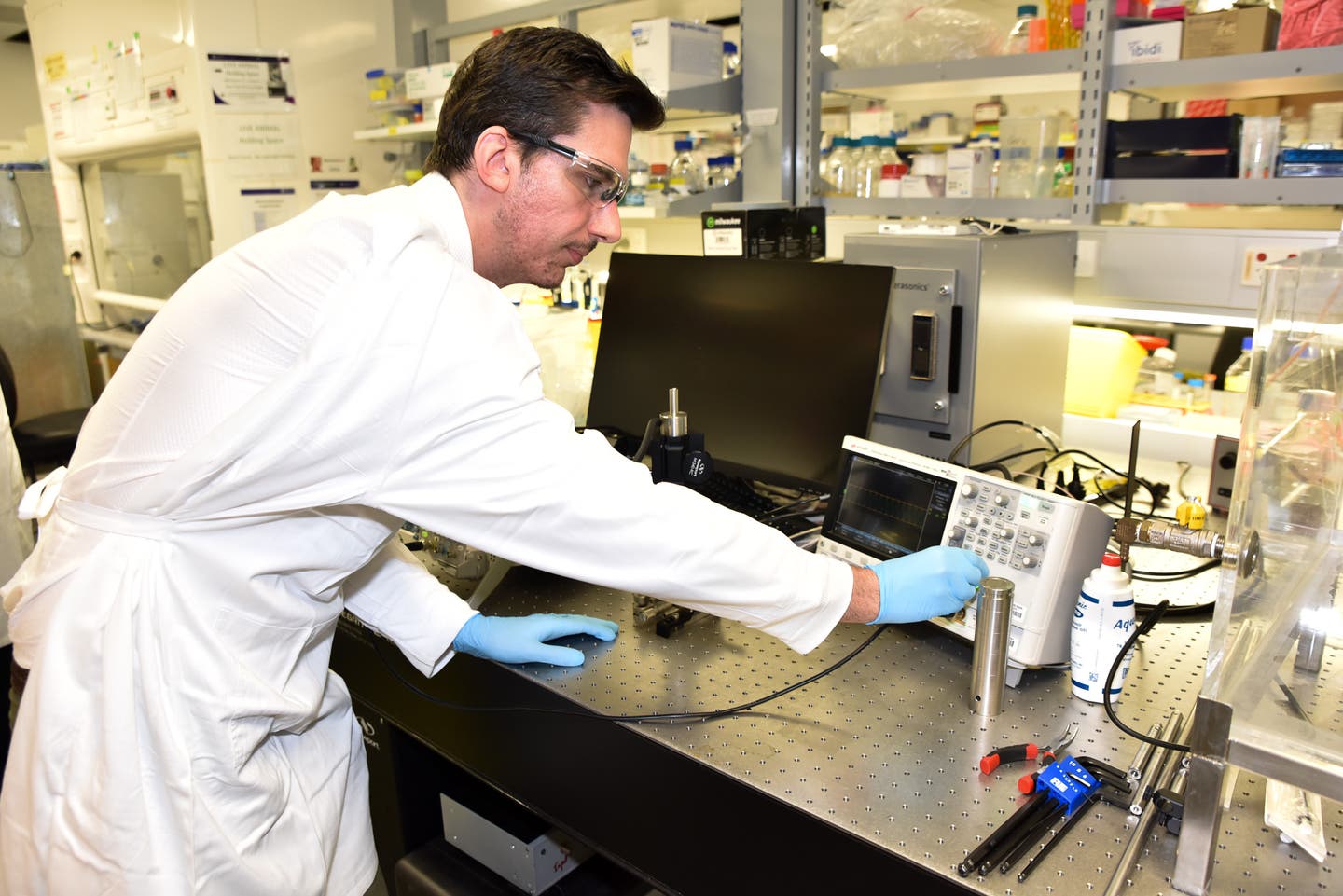Ultrasound shows promise as a treatment for Alzheimer’s disease, study finds
Researchers have discovered that ultrasound treatment can enhance cognitive function in neurodegenerative disorders.

Dr Gerhard LEinenga monitoring ultrasound waves with an oscilloscope. (CREDIT: UQ's Queensland Brain Institute)
Researchers at UQ's Queensland Brain Institute have discovered that ultrasound treatment can enhance cognitive function in neurodegenerative disorders without specifically targeting amyloid plaque in the brain.
Dr. Gerhard Leinenga and Professor Jürgen Götz, from the Clem Jones Centre for Ageing Dementia Research, challenge the prevailing belief in Alzheimer’s disease research that clearing amyloid plaque is crucial for cognitive improvement.
Amyloid plaques, protein clusters that obstruct communication between brain cells, are associated with memory loss and other Alzheimer's symptoms.
(LEFT) Professor Jürgen Götz and (RIGHT) Dr Gerhard Leinenga. (CREDIT: UQ's Queensland Brain Institute)
Previous studies focused on using microbubbles to open the blood-brain barrier, activating microglia to clear amyloid plaque. However, Dr. Leinenga and his team utilized scanning ultrasound alone on mouse models and noted significant memory enhancement.
Dr. Leinenga emphasizes that ultrasound alone induces lasting cognitive changes and memory improvement, suggesting direct effects on neurons such as increased plasticity and improved brain networks. While ultrasound doesn't specifically clear plaques, it enhances brain resilience to them.
Professor Götz highlights the importance of ultrasound frequency, with higher frequencies showing superior results compared to those in current clinical trials for Alzheimer’s. The researchers aim to integrate these findings into Professor Götz’s ultrasound safety trial for Alzheimer’s treatment.
Related Stories
Understanding ultrasound therapy mechanisms could lead to tailored treatment strategies, maximizing cognitive improvement in neurodegenerative disorders. This approach represents a significant stride toward personalized and effective therapies.
The research paper has been published in Molecular Psychiatry.
Who has Alzheimer’s Disease?
In 2020, as many as 5.8 million Americans were living with Alzheimer’s disease.
Younger people may get Alzheimer’s disease, but it is less common.
The number of people living with the disease doubles every 5 years beyond age 65.
This number is projected to nearly triple to 14 million people by 2060.
Symptoms of the disease can first appear after age 60, and the risk increases with age.
What is known about Alzheimer’s Disease?
Scientists do not yet fully understand what causes Alzheimer’s disease. There likely is not a single cause but rather several factors that can affect each person differently.
Age is the best known risk factor for Alzheimer’s disease.
Family history—researchers believe that genetics may play a role in developing Alzheimer’s disease. However, genes do not equal destiny. A healthy lifestyle may help reduce your risk of developing Alzheimer’s disease. Two large, long term studies indicate that adequate physical activity, a nutritious diet, limited alcohol consumption, and not smoking may help people.
Changes in the brain can begin years before the first symptoms appear.
Researchers are studying whether education, diet, and environment play a role in developing Alzheimer’s disease.
There is growing scientific evidence that healthy behaviors, which have been shown to prevent cancer, diabetes, and heart disease, may also reduce risk for subjective cognitive decline.
What is the burden of Alzheimer’s disease in the United States?
Alzheimer’s disease is one of the top 10 leading causes of death in the United States.
The 6th leading cause of death among US adults.
The 5th leading cause of death among adults aged 65 years or older.
In 2020, an estimated 5.8 million Americans aged 65 years or older had Alzheimer’s disease. This number is projected to nearly triple to 14 million people by 2060.
Professor Götz with the scanning ultrasound machine. (CREDIT: UQ's Queensland Brain Institute)
In 2010, the costs of treating Alzheimer’s disease were projected to fall between $159 and $215 billion. By 2040, these costs are projected to jump to between $379 and more than $500 billion annually.
Death rates for Alzheimer’s disease are increasing, unlike heart disease and cancer death rates that are on the decline.
Dementia, including Alzheimer’s disease, has been shown to be under-reported in death certificates and therefore the proportion of older people who die from Alzheimer’s may be considerably higher.
For more science news stories check out our New Discoveries section at The Brighter Side of News.
Note: Materials provided above by The Brighter Side of News. Content may be edited for style and length.
Like these kind of feel good stories? Get the Brighter Side of News' newsletter.
Joshua Shavit
Science & Technology Writer | AI and Robotics Reporter
Joshua Shavit is a Los Angeles-based science and technology writer with a passion for exploring the breakthroughs shaping the future. As a contributor to The Brighter Side of News, he focuses on positive and transformative advancements in AI, technology, physics, engineering, robotics and space science. Joshua is currently working towards a Bachelor of Science in Business Administration at the University of California, Berkeley. He combines his academic background with a talent for storytelling, making complex scientific discoveries engaging and accessible. His work highlights the innovators behind the ideas, bringing readers closer to the people driving progress.



